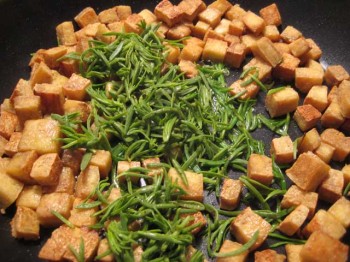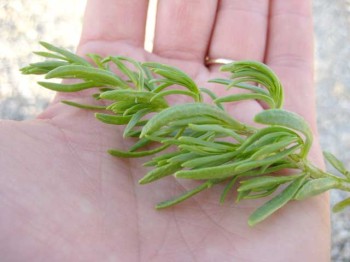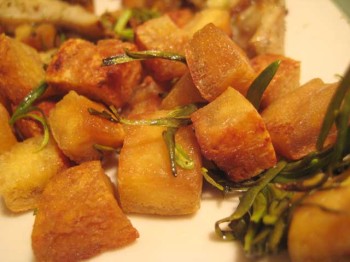
Last night I all but destroyed the kitchen, scurrying about cooking up a wild feast like a person possessed. It felt good to be back home experimenting with wild ingredients again after our recent road trip to parts west, to channel all that inspiration from finding exciting new plants into food while my better half lounged on the couch. And, of course, it was snowing while I did so, here in the last stronghold against spring at 10,000 feet in the Colorado Rockies.
One of the dishes I made uses the leaves of black greasewood (Sarcobatus vermiculatus). The sprigs of the desert shrub had been sitting in the refrigerator for the last week and a half or so since we gathered them from a Nevada alkali flat. Not because I’d forgotten about them—rather because I was leery of the odd new plant, and awaiting responses to my recent query in the Edible Wild Plants group on Facebook as to whether anyone had eaten it before. Fortunately Brad VanDyke, based in Utah, responded: “I have eaten it, and like it. However, it does contain oxalates, so be careful,” he wrote. As certain commercial veggies we consume—like spinach—contain oxalates too, I took that to mean: Don’t overeat. As in an entire pound in a sitting.

I’d identified the plant using Shrubs and Plants of the Southwest Uplands (1976) by Francis H. Elmore, a loaner book from B that describes it as “a coarse, scraggly, much-branched shrub from 2 to occasionally 8 feet tall” with “narrow, fleshy leaves,” “gray-whitish or tan-colored bark,” and “spreading, rigid branches.” The book also states that native people ate the leaves and seeds. So, emboldened by recent foraging successes and Brad’s endorsement, I finally cooked some up last night.
I started with frozen tofu that I thawed out, though I normally detest the sponge-like texture of thawed tofu. But I’d stuffed it in the freezer before our recent road trip so it wouldn’t spoil, and I didn’t want to waste it. I squeezed the thawed tofu over the sink before cutting it up and sautéing it in oil on medium heat for probably an hour, dousing once with much Bragg liquid aminos (like soy sauce), and cooking until all sides were crispy. I was surprised how well the tofu—which yes, I acknowledge, has a bad reputation—turned into something crunchy, airy, and good.

Then at various points during the cooking I sprinkled in the black greasewood leaves to get a sense for how they cooked up, adding oil too as needed. The leaves I’d dumped in early crunched up, which was a fine texture addition for me, though when I took the pan off the heat for a while to prepare the other dishes I noticed that some of them blackened. I don’t think it affected the taste, however. Later, when all the food was ready, I dropped in another ¼ cup of the thick, narrow leaves, which are almost like pine needles, doused once more with the soy, and served.
The dish came out salty and crunchy and not unappealing in texture, though the black greasewood leaves got somewhat lost in the mix. Still, I’d do it again. The rest of the leaves are now drying for a next phase of experimentation, and I have some sprigs soaking in oil too. No ill effects to report as of noon today.

Leave a Reply